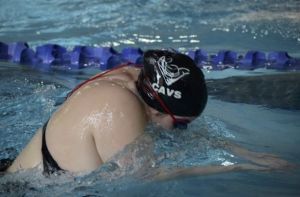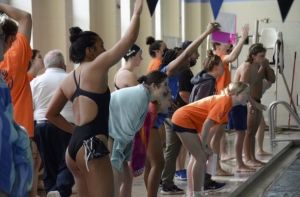In sports, athletes are always told to push themselves and that if there is no pain there is no gain. Has anyone thought that maybe they should listen to their body when they are in pain?
Swimming is a low impact sport. Sports that are considered low impact would be activities where there is little to no trauma to weight-bearing joints. Some on the list would be bowling, golfing, sailing and of course swimming.
Naturally with swimming being low impact on the body, people would think there are not a lot of injuries that are involved with the sport but that is not necessarily true. The most common injury to athlete swimmers are shoulder injuries. Injuries such as rotator cuff impingement, rotator cuff tears, tendonitis and bursitis can all affect swimmers at some point in their career.

Unfortunately, swimmer Lauren Belardo is no stranger to this pain. She suffers from AMPS. AMPS stands for Amplified Musculoskeletal Pain Syndrome. This is a condition that is characterized by chronic pain in the muscles, joints or other parts of the body.
AMPS is mostly triggered by injury but the cause is not well understood yet.
Swimming can cause a lot of injuries, but Belardo does not believe that the sport caused her AMPS. In Sept. of 2017, Belardo woke up with shoulder and neck pain.
“I thought I just slept on it wrong,” she said. She just ignored the pain but eventually it would not go away. After a few weeks she went to see a doctor and that doctor diagnosed her with Torticollis. Torticollis is a rare condition that causes the neck muscles to contract and freeze. To help with the Torticollis Belardo went to a chiropractor where she got heat treatments for relief.
Many doctors appointments, x-rays, MRIs and bloodwork and everything came back inconclusive. She eventually went to a doctor that diagnosed her with AMPS. This is when everything made sense and she was happy she got a diagnosis.
During this period of time with the diagnosis, tests and physical therapy, Belardo had to stop swimming until she was treated with the correct physical therapy and gained her strength back.
Belardo recalls the first time getting back into the water as very emotional.

“It was amazing, it felt like I had my life back. I was so excited to be able to get back in,” Belardo said. The fact that she could get back in the pool again was very exciting but all those happy emotions were also met with some sad ones.
“I wasn’t able to just hop back in and be the swimmer that I once was,” Belardo said. She had to gain her strength back and get her times back down before she was diagnosed. It was hard for her because she was unable to do full practices with the team at Cabrini.
“I talked to the head coach of swimming at Cabrini.” Belardo said that as an incoming freshman she was very transparent about her struggles. Today Belardo is a proud member of the Cabrini swim team and is very happy to report that she is losing time in all of her events.
“My times are getting better each swim and for all that I have been through I am pretty proud of myself,” Belardo said.


